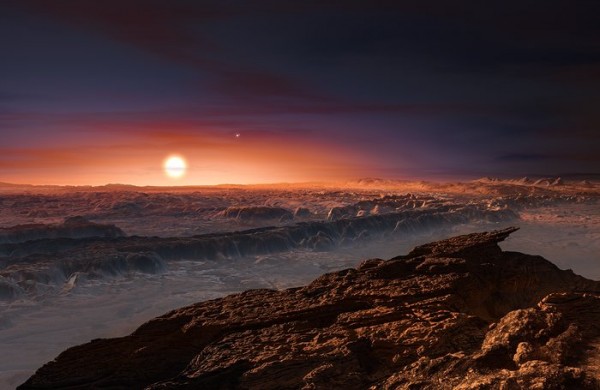By Ana Verayo, | October 10, 2016

This artist’s impression shows a view of the surface of the planet Proxima b orbiting the red dwarf star Proxima Centauri, the closest star to its Solar System.
A newly discovered planet known as Proxima b was thought to have the potential to host life. But now scientists say that it is an "ocean planet" with water covering its entire surface.
Researchers from the Marseille Astrophysics Laboratory determined this presence of water on the surface of the planet, which could be home to alien life.
Like Us on Facebook
Proxima Centauri is the closest star system to our solar system. Proxima b lies within the habitable zone of its system. This means that it is not too near or far from its sun to create ideal conditions for water. It is around 1.3 times the size of Earth, located 4.22 light years away.
Scientists believe that this is the first exoplanet that can be visited by robotic probes from Earth. However, to reach Proxima b, current spacecraft technologies will need of travel 70,000 years to reach it.
In this new study, scientists were able to calculate the dimensions of the surface of Proxima b. They suggest that this planet is entirely covered by a global liquid ocean estimated to be 200 kilometers deep.
However, compared to Earth, Proxima b is much closer to its star. However, since Proxima Centauri is a red dwarf, it is a cooler star than our sun yet temperate enough to sustain life. The team said that Proxima b is in an orbit that allow conditions for liquid water on its surface, which means it can support life. The water on the surface of the planet would potentially harbor life forms.
According to the lead author of the study, Bastien Brugger of the Marseille Astrophysics Laboratory, thousands of planets have been discovered. However, Proxima b is one of the best candidates for potential life. He added that there could still be life on the planet today and not only during its early formation.
This new study has been published in the Astrophysical Journal Letters.
-
Use of Coronavirus Pandemic Drones Raises Privacy Concerns: Drones Spread Fear, Local Officials Say

-
Coronavirus Hampers The Delivery Of Lockheed Martin F-35 Stealth Fighters For 2020

-
Instagram Speeds Up Plans to Add Account Memorialization Feature Due to COVID-19 Deaths

-
NASA: Perseverance Plans to Bring 'Mars Rock' to Earth in 2031

-
600 Dead And 3,000 In The Hospital as Iranians Believed Drinking High-Concentrations of Alcohol Can Cure The Coronavirus

-
600 Dead And 3,000 In The Hospital as Iranians Believed Drinking High-Concentrations of Alcohol Can Cure The Coronavirus

-
COVID-19: Doctors, Nurses Use Virtual Reality to Learn New Skills in Treating Coronavirus Patients







